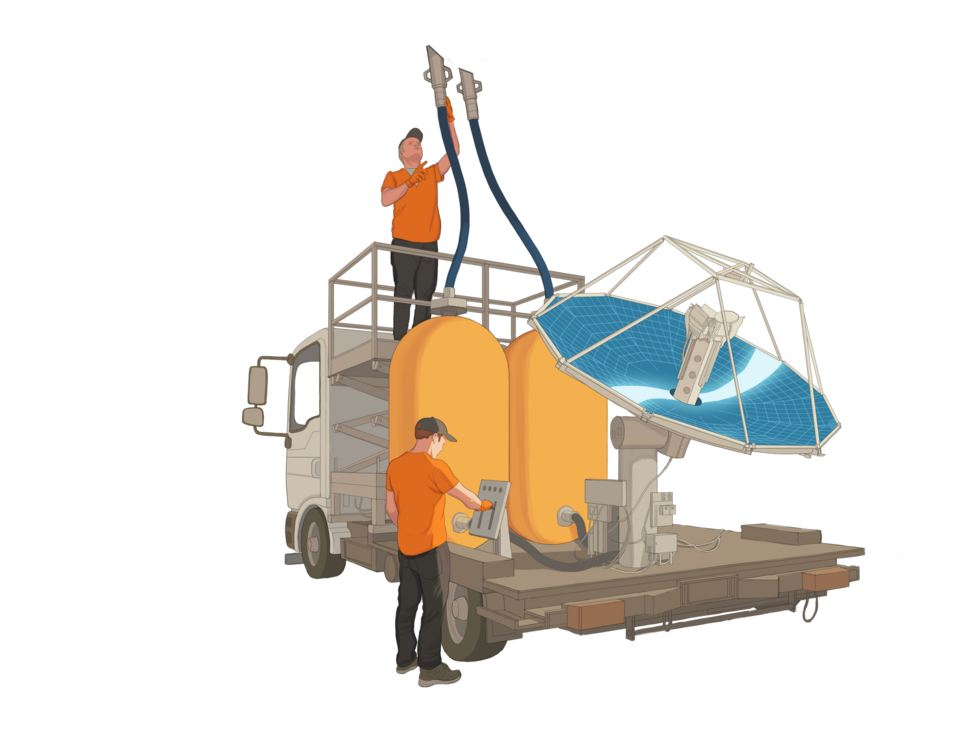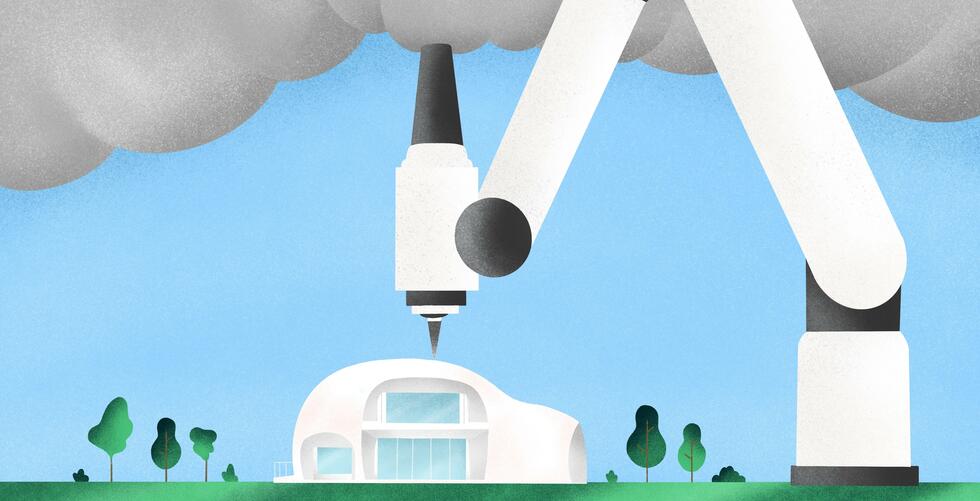An end to flight shame
Will we ever be able to fly with a clean conscience again? The good news: Technologies for zero-carbon aviation are already available today. The bad: It will take years to bring them to market.

In medieval times, Christians were able to buy themselves free of their sins in order to avoid purgatory. Nowadays, the indulgence trade is celebrating a renaissance. The modern human being is no longer as ashamed of deadly sins such as gluttony or sloth, but rather of frequent flying. Carbon offsetting schemes are the indulgence letters of our time. At least the proceeds are not simply invested in church ornaments but in climate projects. Nevertheless, it appears that only a small minority are prepared to pay for their climate sins: Only one to two percent of all flights are offset.
Rather than offsetting, it would be more appropriate to not fly in the first place. But hardly anyone is prepared to abstain from flying as radically as the young climate activist Greta Thunberg. Because in defiance of all flight shame: Air traffic will continue to increase; according to forecasts by around five percent each year. This means that even just to maintain the carbon emissions of air travel at their current level, which account for almost three percent of all global CO₂ emissions, a reduction in pollutants will be necessary. The CORSIA initiative launched by the International Civil Aviation Organization (ICAO) calls for the growth of air traffic to be carbon-neutral from 2020 onwards.
E-jets remain a vision of the future
So how can flying be made cleaner? One solution would be zero-emission propulsion. But while e-mobility is already making great strides on the road, it still has a hard time taking to the air: Batteries are too heavy, the energy needs too high, and the ranges too short. Although there are countless e-flight projects and promising drone taxi prototypes, advances in the field of electric passenger aircraft have been rather modest so far.
In other words, we will have to wait at least another decade for fully-fledged e-jets. Thus, we have to pin all our hopes on alternative fuels – and these have in fact been around for a long time.
Airbus plans to fly a prototype of its E-Fan X model in the near future, but the jet is in fact a hybrid: only one of its four turbines is electrically powered. By 2030, together with the US start-up Wright Electric, EasyJet intends to develop an e-plane that is capable of one-hour flights with 100 passengers.
In other words, we will have to wait at least another decade for fully-fledged e-jets. Thus, we have to pin all our hopes on alternative fuels – and these have in fact been around for a long time. As early as 2007, the International Air Transport Association (IATA) set itself the goal that aviation biofuel should account for ten percent of total kerosene consumption by 2017. The fact that this target was not achieved is due, among other things, to the lack of incentives to move away from fossil fuels: In contrast to car fuels, kerosene is not subject to tax and at roughly 50 cents per liter, it is only a fraction of the price.

Biokerosene is not necessarily clean
Even among climate activists, aviation biofuel has always been controversial, because it is not inherently environmentally or socially sustainable. When Lufthansa started testing alternative fuels in 2011, the project came under criticism because its supplier Neste, the world’s leading producer of biokerosene, was at that time still using palm oil. And just as with biofuel for road vehicles, which is produced from corn or rapeseeds, aviation biofuel also carries the risk of displacement effects: Its production uses agricultural land that would be better utilized to grow food.
With second-generation aviation biofuel, however, the fuel tank and dinner plate are no longer in competition. For example, the Technical University of Munich, in cooperation with Airbus, is running a state-of-the-art cultivation project for algae, which are used to produce oil for aviation biofuel. The Australian airline Qantas is experimenting with mustard seed oil that can be produced industrially. Other researchers are examining exotic plants that can be cultivated on otherwise non-arable land: Jatropha, for example, a nut that grows in the subtropics in soils that are unsuitable for agriculture. Or salicornia, a plant that can grow in saline soils.
Turning organic waste into fuel
Waste can also be used as a raw material for alternative fuels. The underlying technology is the Fischer-Tropsch process, which was invented in Germany almost 100 years ago and which was used during wartime to produce fuel from coal. The process uses pyrolysis – the decomposition of organic materials at elevated temperatures in the absence of oxygen – to convert biomass into synthesis gas, a mixture of hydrogen, carbon monoxide, and carbon dioxide. This can then be converted into synthetic fuel.
In this way, the Californian company Fulcrum Bioenergy produces biokerosene from organic waste and supplies it to United Airlines. In 2022 a similar aviation biofuel refinery will be commissioned in the Netherlands. In Delfzijl on the North Sea, Sky NRG plans to produce 100,000 metric tons of fuel a year, three quarters of which is to be purchased by the KLM airline. The airline thus intends to reduce its carbon emissions by 85 percent.
Kerosene from solar and wind energy
In addition to these biomass-to-liquid processes, there are now also power-to-liquid processes that do not require biomass as the basis for fuel production and which, in a sense, eliminate the detour via photosynthesis.
The Swiss Federal Institute of Technology (ETH) in Zurich has developed a method that requires nothing more than sunlight and air: CO₂ and water are extracted directly from the ambient air and separated using solar energy. The resulting product is syngas, which can subsequently be processed into biokerosene. The University of Bremen is currently carrying out similar experiments on the North Sea coast using excess wind-generated electricity.
Meanwhile, the Chicago-based start-up Lanzatech is focusing on a method that captures emissions from chemical plants and steel mills and converts them into ethanol. This bio-ethanol can also be used to produce zero-carbon kerosene.
There is an abundance of innovative approaches. Although fuels produced using power-to-liquid processes also release CO2 during combustion, they can be considered as carbon-neutral because CO2 is extracted from the air during production.
So there is an abundance of innovative approaches. Although fuels produced using power-to-liquid processes also release CO₂ during combustion, they can be considered as carbon-neutral because CO₂ is extracted from the air during production. However, the problem of contrails remains unsolved. Even alternative fuels release water vapor when they are combusted, which is climate-relevant because it can lead to increased cloud formation and thus have an impact on the weather.
Who will bear the additional costs?
The methods for producing carbon-neutral kerosene are already available. Now, the challenge is to adapt them for production on an industrial scale. Because, the current experimental facilities – be it the University of Munich’s algae farm, ETH Zurich’s solar refinery, or the University of Bremen’s wind energy refinery – can only produce small quantities of fuel.
If alternative fuels are to be made commercially viable, there must not only be a supply but also a demand. Currently, aviation biofuel is three to five times more expensive than normal kerosene, and in the competitive aviation sector, nobody is prepared to bear these additional costs. Airlines such as Lufthansa, Finnair, and KLM intend to offer customers the option of paying a surcharge for biokerosene. However, it is to be feared that as few frequent flyers will make use of such offers as they do of carbon offsetting – especially since the price will be significantly higher. The surcharge could amount to more than half of the ticket price.
Without incentives, nothing will change
It will be years before we have the infrastructure to meet the entire annual demand for more than 100 million tonnes of kerosene with carbon-neutral fuel. And for this to happen at all, incentives are essential. This has been clearly demonstrated by solar and wind energy: Subsidies are required to create a market for environmentally friendly alternatives.
At the same time, politicians must hold the airlines to account, for example by imposing a kerosene tax. A possible incentive would also be biokerosene quotas. Norway is setting a good example: Since January 2020, every airliner is required to use alternative kerosene – even if only as an admixture of half a percent. In ten years, this quota is set to rise to 30 percent. In this way, a market for alternative fuels could be gradually created. It is therefore conceivable that we will be able to fly with a clear conscience during the course of the next decade.

Written by:
Illustration: Daniel Garcia









































































































